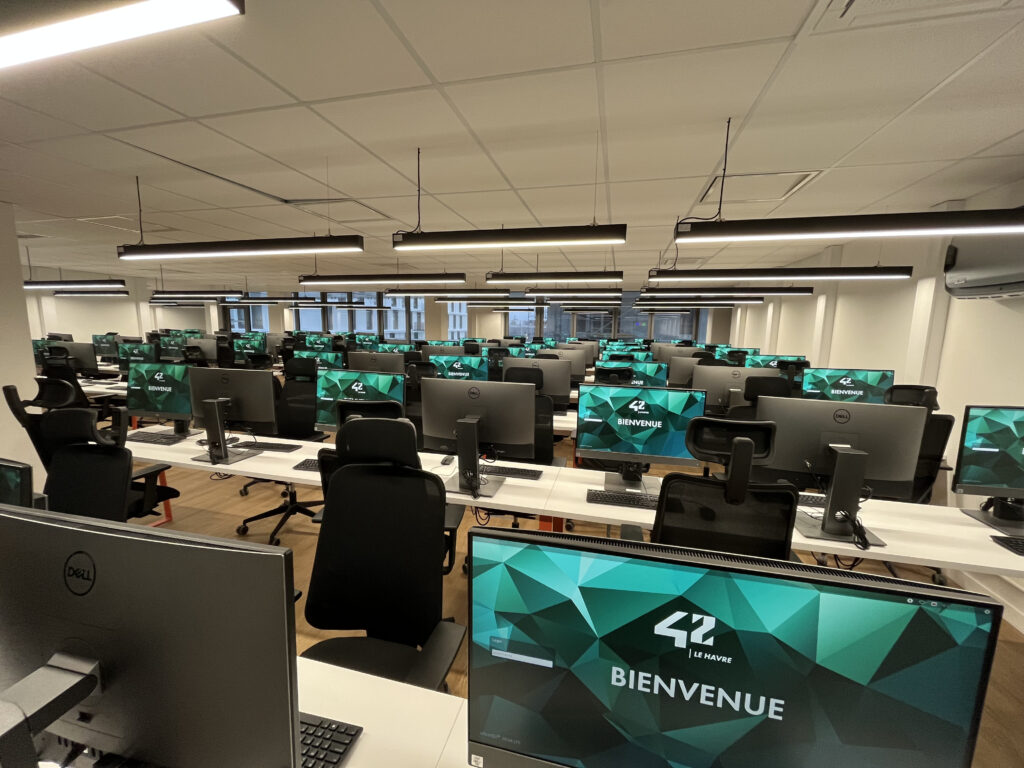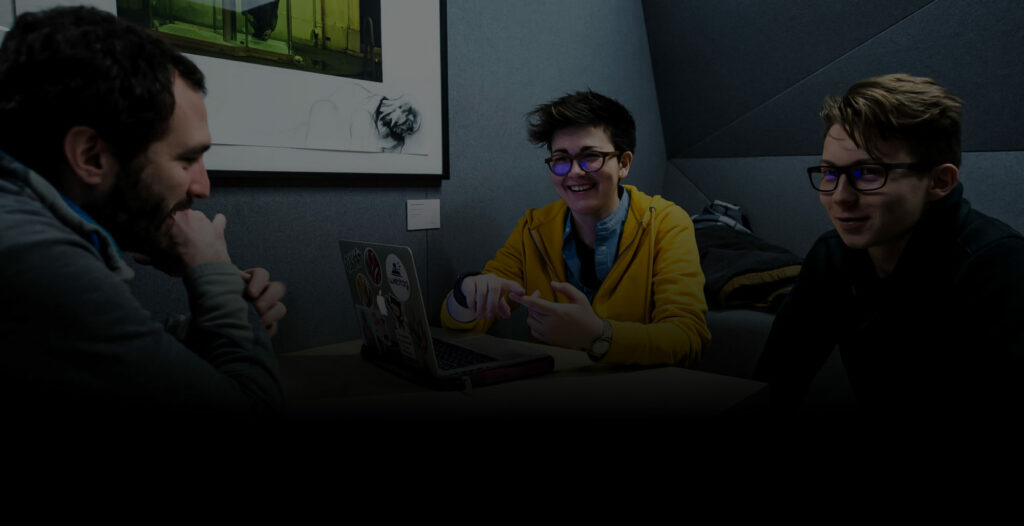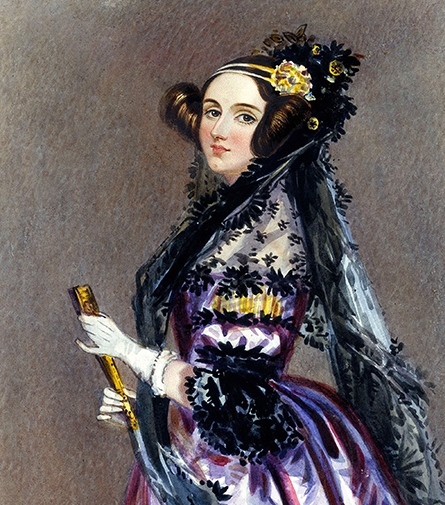
THE 42 PEDAGOGY
What makes 42 a unique, innovative training program, in line with the needs of the market, while shaking up the codes of education?
OUR PILLARS
THE BASES OF 42
NO LESSONS. NO TEACHERS. NO CLASSES.
Thanks to its innovative pedagogy, 42 is able to offer excellent training without relying on traditional lectures. The teaching team supports students in finding their own solutions. To make progress at 42:
- One must work in groups,
- Draw on the community to push themselves to the limit,
- Share their knowledge with their peers.
Learning computer science by taking notes in front of a board and writing programs on paper is out of the question!
PROJECT-BASED TRAINING
The students at 42 are the protagonists of their success through a 100% practical curriculum.
Pushing oneself is the way forward: you can always rely on the strength of the group, give and receive information, and take turns teaching and learning.
This developing collective intelligence brings us closer to the world of work. All parties are responsible for the success of a project led by many.
TO FAIL IS TO MOVE FORWARD
Failure is valued at 42. It’s the path to success: testing a program, realizing your mistakes, correcting them, and going further. Learning at 42 rewards the personal search for solutions. It’s not about copying a model without understanding it. The final success is the only thing that matters, regardless of whether the journey is quick or a bit longer.
PEER-TO-PEER LEARNING
When entering 42, it’s no longer about waiting for knowledge to be imparted by someone who ‘knows.’ You have to be ready to seek it out yourself, go to your peers to understand it before implementing it, and explain how it works to others. This exercise allows you to advance and sharpen your abilities by searching, experimenting, and defending your ideas.
PEER-TO-PEER EVALUATION
In traditional learning, correction comes at the end of the learning process. At 42, it’s the moment when you learn the most. Peer assessments require students to rate each other using a scale established by the pedagogical team. Rather than fearing a grade, open dialogue allows for receiving essential advice to progress and discovering alternative approaches.
Each project is assessed by multiple peers and sometimes supplemented with automatic correction. During the common core program, these evaluations are complemented by 5 machine exams.
WORKING IN GROUPS IS NOT CHEATING
In a traditional classroom, collaborating with others to solve an exercise or exchange advice is often frowned upon. At 42, it’s the opposite. When projects seem impossible to complete, forming a study group allows progress by sharing perspectives. By getting closer to people who also have doubts and don’t have all the answers, different viewpoints are brought together. Everyone contributes something so that the skills necessary for the success of a project are acquired together.

GAMIFICATION
PLAYFUL LEARNING
To increase both the quality of learning and the well-being of students, 42 offers a motivating and entertaining environment rooted in the theme of gaming. When you make a mistake, you start over until you succeed, just like in a video game. Each project completed earns experience points and allows you to advance to higher levels. Progress in the curriculum and developed skills are displayed on each student’s personal intranet space. There are even rewards for certain significant achievements and coalitions to compete with others.

DEALING WITH TOMORROW
WHY LEARNING TO LEARN
Learning how to learn means being able to renew oneself throughout one’s career. When you graduate from 42, no programming language or technology is out of reach, whether it already exists or not! That’s why 42 offers a sustainable education. It is the opposite of training programs solely focused on learning specific or ‘trendy’ technologies that quickly become obsolete. How can we invent the future if we only memorize technologies from the past?
DURATION OF THE TRAINING
A 3-YEAR PROGRAM... ON AVERAGE
Not everyone learns at the same pace, so why impose a single one? The 42 program does not follow an administrative or school calendar. On average, students find lasting employment after 3 years. The curriculum is divided into two parts: the common core and the second part with its computer specializations. The common core should be completed in a maximum of one and a half years. The second part can take longer, depending on the chosen directions. It’s up to everyone to organize themselves: for example, most of the required projects have a realistic time estimate rather than a set deadline.
INITIAL DURATION
The maximum duration of one and a half years for the common core is quite generous for students who are committed to their studies. It allows you to progress at your own pace while also accommodating those who need to work or want to deepen their skills.
FREEZE
Students have a tool at their disposal to deal with unforeseen circumstances: the Freeze. It allows you to pause your course, up to a maximum of 3 times, for a total duration not exceeding 6 months.
LAUNCHPAD
After the common core program, our students are inevitably drawn to the job market. In this context, we give them the opportunity to decide the end of their course to become alumni. This transition can also occur after a period of inactivity and a certain level of skills obtained.

GEEK CULTURE
WHO WAS THE FIRST PERSON TO HAVE PROGRAMMED?
Strangely, the first object that most closely resembles a computer program predates the creation of a computer! In the 19th century, Ada Lovelace, an English noblewoman passionate about mathematics, decided to translate the works of Charles Babbage on the Analytical Engine, a prototype of a calculating machine. Encouraged by the quality of her work, she added several appendices to the original document, which represented more than three times the initial size of the work. The last one, Appendix G, contains the first algorithm for calculating Bernoulli numbers.
It was in 1843: Ada Lovelace became the first person in the world to have programmed.
